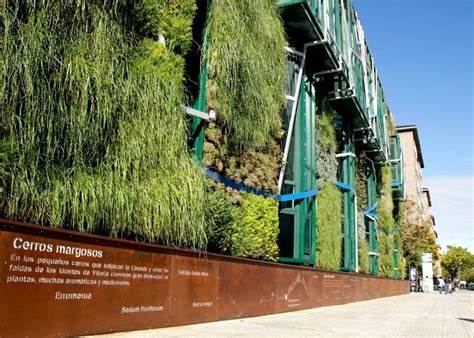
Vertical Gardens for Cooling Urban Areas: Enhancing Sustainable Urban Development
Introduction
The concept of vertical gardens for cooling urban areas has gained significant attention in recent years. As cities face the challenges of climate change and urbanization, finding innovative solutions to mitigate the heat island effect and improve the quality of urban environments has become crucial. In this article, we will explore the historical background, key concepts, benefits, design considerations, integration in urban planning, case studies, current trends, challenges, and future outlook of vertical gardens for cooling urban areas.
Historical Background
The idea of vertical gardens can be traced back to ancient civilizations such as the Hanging Gardens of Babylon. However, it wasn’t until the 20th century that the concept gained prominence in contemporary urban planning. Notable pioneers in vertical gardening for cooling urban areas include Patrick Blanc, who developed the concept of green walls, and Stanley Hart White, who introduced the idea of rooftop gardens.
Key Concepts and Definitions
Vertical gardens, also known as green walls or living walls, are vertical structures that support plant growth on building façades or walls. Their purpose in cooling urban areas is to mitigate the urban heat island effect, which refers to the phenomenon where cities experience higher temperatures due to the concentration of buildings and human activities. Vertical gardens can help reduce ambient temperatures by providing shade, evaporative cooling, and enhancing air circulation. Green infrastructure, evaporative cooling, and microclimates are also relevant terms to understand in the context of vertical gardens.
Main Discussion Points
Benefits of vertical gardens for cooling urban areas
Vertical gardens offer numerous benefits in terms of cooling urban areas. Firstly, they reduce ambient temperatures by providing shade and evaporative cooling. This is achieved through the plants’ ability to absorb solar radiation and release water vapor through transpiration, effectively cooling the surrounding air. Secondly, vertical gardens improve air quality by absorbing pollutants and releasing oxygen. This contributes to a healthier and more pleasant urban environment. Lastly, vertical gardens can lead to energy savings and reduced carbon emissions as they provide natural insulation, reducing the need for artificial cooling systems.
Design considerations for effective vertical gardens
To ensure the effectiveness of vertical gardens, careful consideration must be given to plant species selection, especially in different climates. Native or adaptive plants that are drought-tolerant and require minimal maintenance are ideal choices. Additionally, irrigation and watering systems should be designed to optimize water usage and prevent water runoff. Structural support and maintenance plans should also be considered to ensure the longevity and functionality of vertical gardens.
Integration of vertical gardens in urban planning
Vertical gardens can be seamlessly integrated into buildings and infrastructure as part of urban planning strategies. They can be incorporated in the design of new constructions or retrofitted onto existing structures. Urban greening policies and regulations can play a crucial role in promoting the widespread implementation of vertical gardens, ensuring their inclusion in urban development plans and guidelines.
Case Studies or Examples
Bosco Verticale in Milan, Italy
The Bosco Verticale, meaning “Vertical Forest,” is a renowned project that exemplifies the positive impact of vertical gardens on urban cooling. This residential complex features two tower buildings covered with more than 900 trees and 20,000 plants. The vertical gardens act as a natural air filter and regulate temperature, reducing energy consumption for heating and cooling. The project has received international recognition for its innovative design and contribution to sustainable urban development.
One Central Park in Sydney, Australia
One Central Park is a high-rise development that incorporates vertical gardens into its design. The project features over 250 species of plants, including hanging gardens and green walls. The vertical gardens provide shade, improve air quality, and contribute to urban cooling. One Central Park serves as a prime example of how vertical gardens can be integrated into high-rise developments, transforming them into sustainable and environmentally friendly spaces.
Current Trends or Developments
Recent research findings have demonstrated the effectiveness of vertical gardens for urban cooling. Studies have shown that vertical gardens can reduce ambient temperatures by several degrees and significantly lower energy consumption. Innovative technologies and materials are being used to enhance vertical garden design, such as modular systems that allow for easier installation and maintenance. Moreover, urban planning initiatives are increasingly promoting the implementation of vertical gardens as a means to create greener, healthier cities.
Challenges or Controversies
Concerns regarding the cost and maintenance of vertical gardens have been raised. The initial investment and ongoing maintenance can be expensive, requiring specialized knowledge and resources. Additionally, the effectiveness of vertical gardens in cooling urban areas may be limited in extremely hot climates or densely built areas with limited open spaces. There are also differing viewpoints on the integration of vertical gardens in urban planning, with some arguing for a more holistic approach that combines multiple strategies for urban cooling.
Future Outlook
The future implications of vertical gardens for cooling urban areas are promising. As cities continue to face the challenges of climate change and urbanization, the implementation of sustainable solutions becomes imperative. Vertical gardens have the potential to play a significant role in creating sustainable and resilient urban environments. Advancements in technology and design will further enhance the efficiency and effectiveness of vertical gardens, making them more accessible and affordable for urban developments.
Conclusion
Vertical gardens offer a sustainable solution for cooling urban areas and improving the quality of urban environments. Through their ability to reduce ambient temperatures, improve air quality, and conserve energy, vertical gardens have become essential in the pursuit of sustainable urban development. By integrating vertical gardens into urban planning strategies and leveraging innovative technologies, cities can create greener, healthier, and more resilient spaces for their inhabitants.